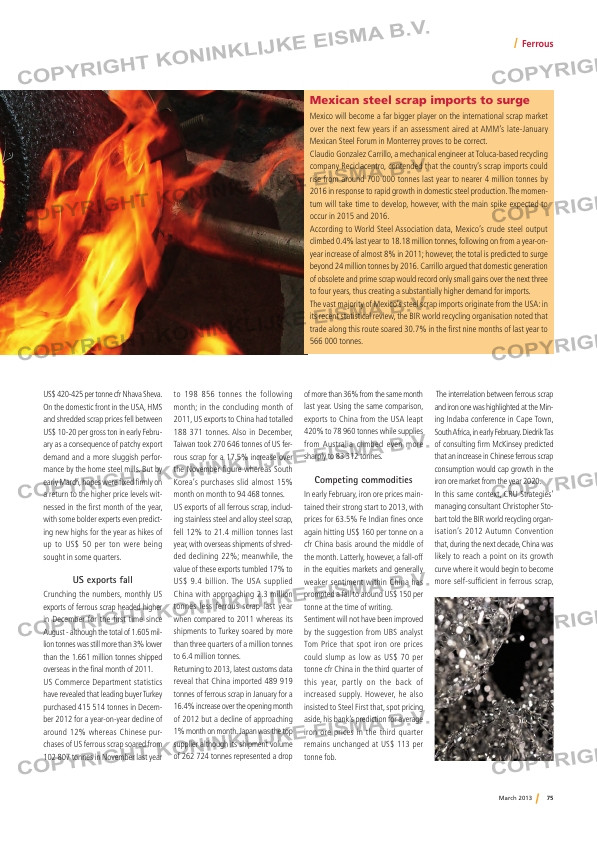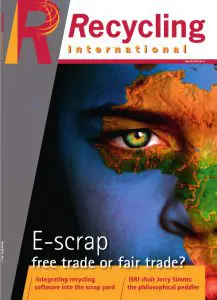Page 75 from: March 2013

75March 2013
Ferrous
US$ 420-425 per tonne cfr Nhava Sheva.
On the domestic front in the USA, HMS
and shredded scrap prices fell between
US$ 10-20 per gross ton in early Febru-
ary as a consequence of patchy export
demand and a more sluggish perfor-
mance by the home steel mills. But by
early March, hopes were fixed firmly on
a return to the higher price levels wit-
nessed in the first month of the year,
with some bolder experts even predict-
ing new highs for the year as hikes of
up to US$ 50 per ton were being
sought in some quarters.
US exports fall
Crunching the numbers, monthly US
exports of ferrous scrap headed higher
in December for the first time since
August – although the total of 1.605 mil-
lion tonnes was still more than 3% lower
than the 1.661 million tonnes shipped
overseas in the final month of 2011.
US Commerce Department statistics
have revealed that leading buyer Turkey
purchased 415 514 tonnes in Decem-
ber 2012 for a year-on-year decline of
around 12% whereas Chinese pur-
chases of US ferrous scrap soared from
102 807 tonnes in November last year
to 198 856 tonnes the following
month; in the concluding month of
2011, US exports to China had totalled
188 371 tonnes. Also in December,
Taiwan took 270 646 tonnes of US fer-
rous scrap for a 17.5% increase over
the November figure whereas South
Korea’s purchases slid almost 15%
month on month to 94 468 tonnes.
US exports of all ferrous scrap, includ-
ing stainless steel and alloy steel scrap,
fell 12% to 21.4 million tonnes last
year, with overseas shipments of shred-
ded declining 22%; meanwhile, the
value of these exports tumbled 17% to
US$ 9.4 billion. The USA supplied
China with approaching 2.3 million
tonnes less ferrous scrap last year
when compared to 2011 whereas its
shipments to Turkey soared by more
than three quarters of a million tonnes
to 6.4 million tonnes.
Returning to 2013, latest customs data
reveal that China imported 489 919
tonnes of ferrous scrap in January for a
16.4% increase over the opening month
of 2012 but a decline of approaching
1% month on month. Japan was the top
supplier although its shipment volume
of 262 724 tonnes represented a drop
of more than 36% from the same month
last year. Using the same comparison,
exports to China from the USA leapt
420% to 78 960 tonnes while supplies
from Australia climbed even more
sharply to 83 312 tonnes.
Competing commodities
In early February, iron ore prices main-
tained their strong start to 2013, with
prices for 63.5% Fe Indian fines once
again hitting US$ 160 per tonne on a
cfr China basis around the middle of
the month. Latterly, however, a fall-off
in the equities markets and generally
weaker sentiment within China has
prompted a fall to around US$ 150 per
tonne at the time of writing.
Sentiment will not have been improved
by the suggestion from UBS analyst
Tom Price that spot iron ore prices
could slump as low as US$ 70 per
tonne cfr China in the third quarter of
this year, partly on the back of
increased supply. However, he also
insisted to Steel First that, spot pricing
aside, his bank’s prediction for average
iron ore prices in the third quarter
remains unchanged at US$ 113 per
tonne fob.
The interrelation between ferrous scrap
and iron one was highlighted at the Min-
ing Indaba conference in Cape Town,
South Africa, in early February. Diedrik Tas
of consulting firm McKinsey predicted
that an increase in Chinese ferrous scrap
consumption would cap growth in the
iron ore market from the year 2020.
In this same context, CRU Strategies’
managing consultant Christopher Sto-
bart told the BIR world recycling organ-
isation’s 2012 Autumn Convention
that, during the next decade, China was
likely to reach a point on its growth
curve where it would begin to become
more self-sufficient in ferrous scrap,
Mexican steel scrap imports to surge
Mexico will become a far bigger player on the international scrap market
over the next few years if an assessment aired at AMM’s late-January
Mexican Steel Forum in Monterrey proves to be correct.
Claudio Gonzalez Carrillo, a mechanical engineer at Toluca-based recycling
company Reciclacentro, contended that the country’s scrap imports could
rise from around 700 000 tonnes last year to nearer 4 million tonnes by
2016 in response to rapid growth in domestic steel production. The momen-
tum will take time to develop, however, with the main spike expected to
occur in 2015 and 2016.
According to World Steel Association data, Mexico’s crude steel output
climbed 0.4% last year to 18.18 million tonnes, following on from a year-on-
year increase of almost 8% in 2011; however, the total is predicted to surge
beyond 24 million tonnes by 2016. Carrillo argued that domestic generation
of obsolete and prime scrap would record only small gains over the next three
to four years, thus creating a substantially higher demand for imports.
The vast majority of Mexico’s steel scrap imports originate from the USA: in
its recent statistical review, the BIR world recycling organisation noted that
trade along this route soared 30.7% in the first nine months of last year to
566 000 tonnes.
RI_2-MA-Ferrous.indd 75 06-03-13 09:30



